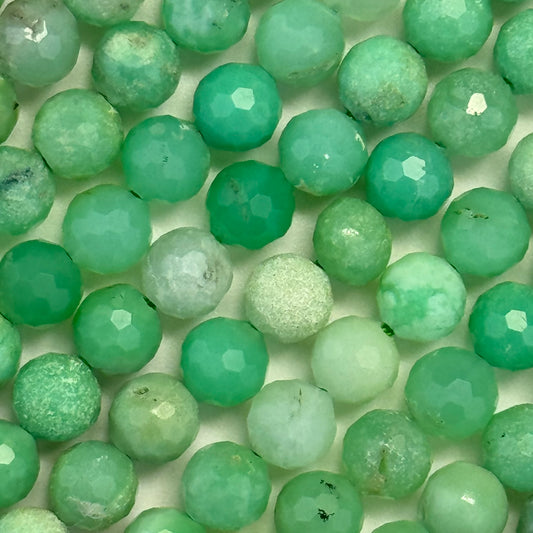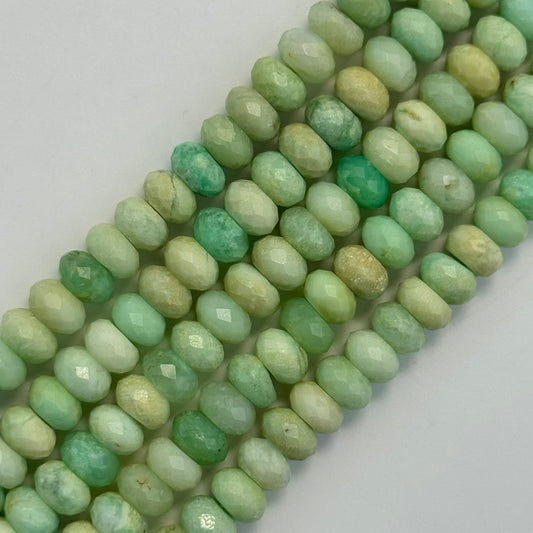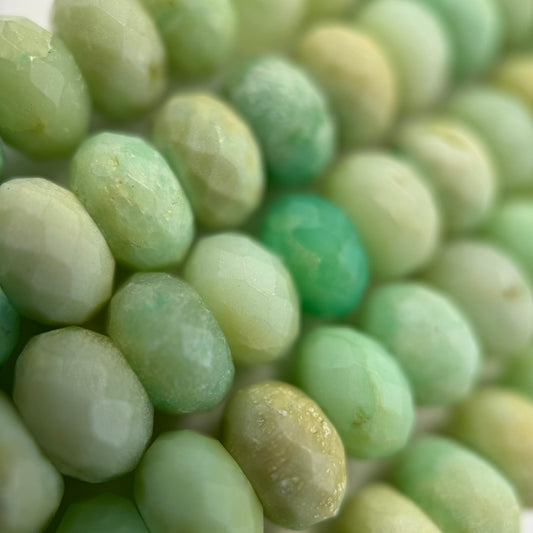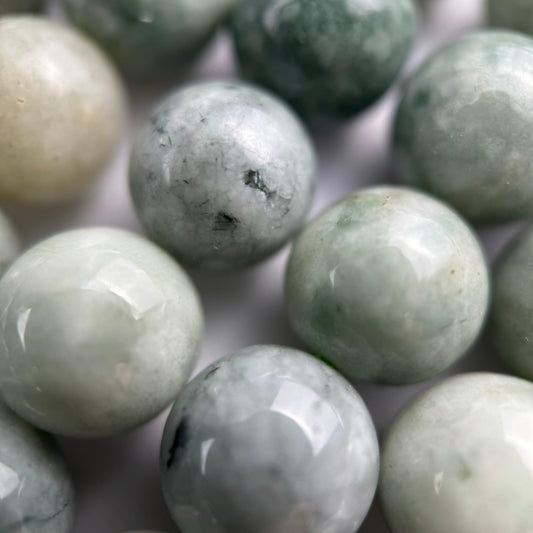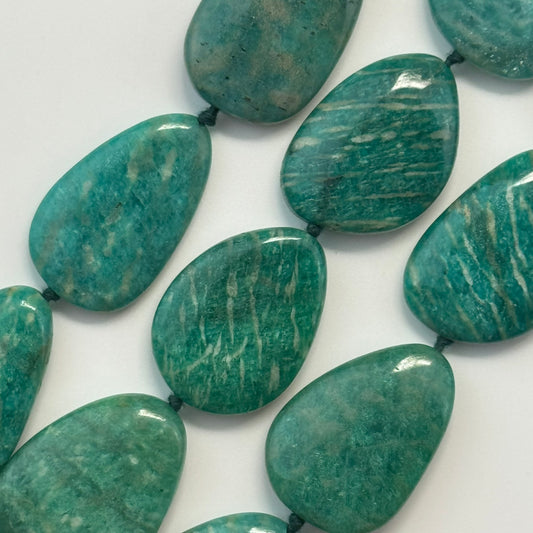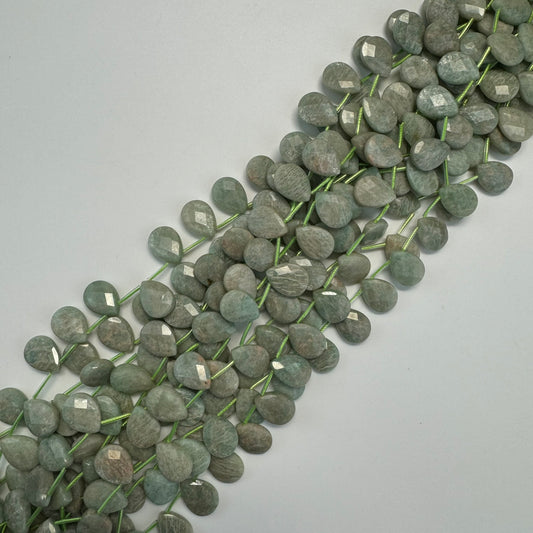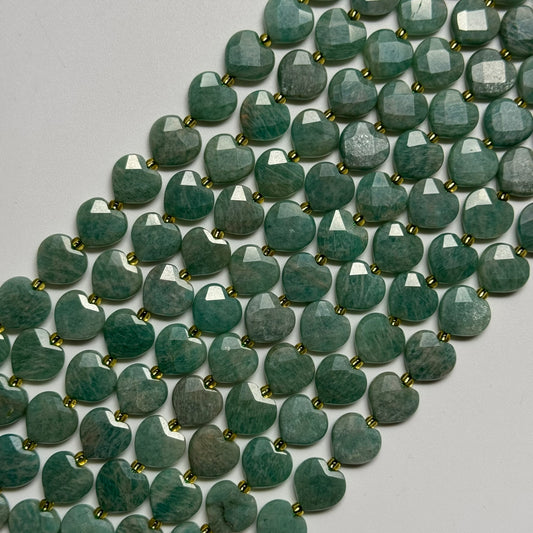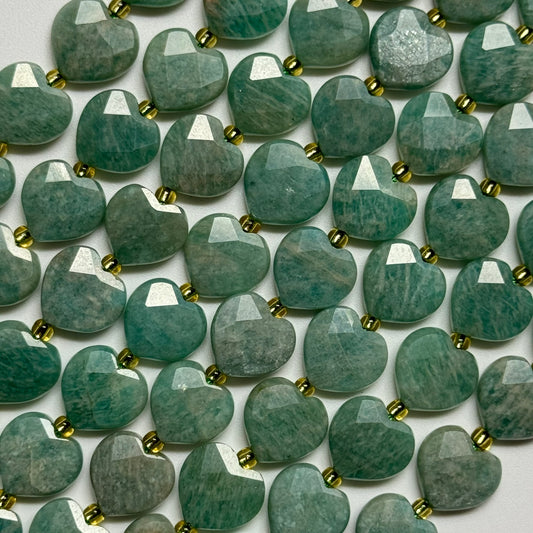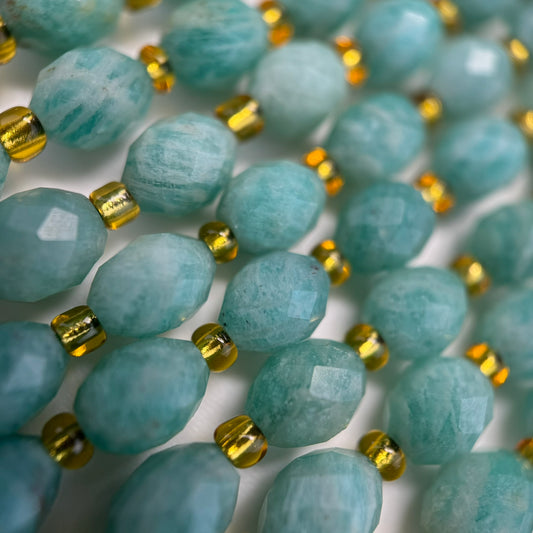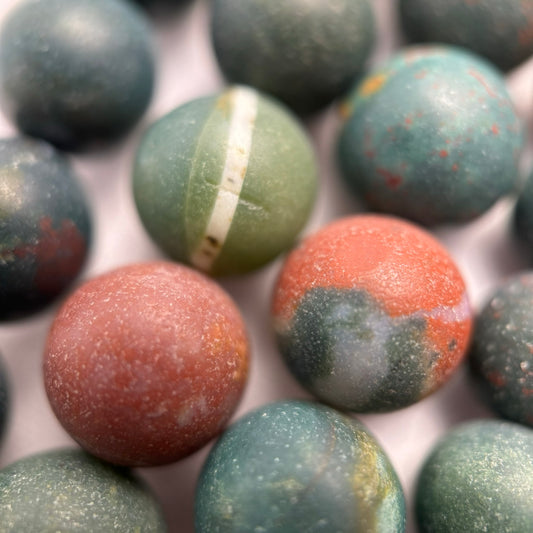Green Precious & Semi Precious Stones
Shop green-colored precious stones. you can find and semi-precious stones, including:
- emerald,
- jade,
- and peridot. These stones are perfect for jewelry making.
Green Precious and Semi-Precious Stone Names
- Emerald (Precious) – Rich/Dark Green: One of the most famous green gemstones; high value, often with inclusions
- Tsavorite Garnet (Semi-Precious) – Bright/Vibrant Green: A rare green garnet, more brilliant than emerald
- Chrome Diopside (Semi-Precious) – Deep Forest Green: Affordable alternative to emeralds
- Green Tourmaline (Semi-Precious) – Light to Deep Green: Also called Verdelite; wide range of green hues
- Peridot (Semi-Precious) – Yellowish Light Green: Often found in volcanic rocks
- Jade (Jadeite/Nephrite) (Semi-Precious) – Pale to Deep Green: Revered in many cultures, especially China
- Demantoid Garnet (Precious, Rare) – Vivid Green: One of the most valuable garnets
- Green Sapphire (Precious) – Light to Dark Green: Rare compared to blue sapphires
- Moldavite (Semi-Precious) – Olive Green: A natural glass formed from meteorite impact
- Aventurine (Semi-Precious) – Medium to Dark Green: Quartz variety with sparkly inclusions
- Seraphinite (Semi-Precious) – Dark Green with Silvery Chatoyance: Rare stone known for feathery patterns
- Malachite (Semi-Precious) – Banded Dark and Light Green: Distinct banding; often used in carvings and beads
- Chrysoprase (Semi-Precious) – Apple Green: A rare, translucent variety of chalcedony
- Prehnite (Semi-Precious) – Pale Green: Translucent stone often used in healing jewelry
- Hiddenite (Semi-Precious) – Pale to Medium Green: Green variety of spodumene; soft and rare
- Green Zircon (Semi-Precious) – Bright Green: Often confused with cubic zirconia but is a natural gemstone
- Gaspeite (Semi-Precious) – Yellowish Green: Rare nickel carbonate mineral; opaque
- Idocrase (Vesuvianite) (Semi-Precious) – Olive to Yellowish Green: Found near volcanoes; translucent to opaque
- Dioptase (Semi-Precious) – Emerald Green: Very vivid color but fragile; usually a collector's stone
- Variscite (Semi-Precious) – Mint Green: Opaque, often confused with turquoise
- Green Apatite (Semi-Precious) – Light to Deep Green: Less common than blue apatite
- Prasiolite (Green Amethyst) (Semi-Precious) – Pale Green: Heat-treated amethyst (quartz)
- Serpentine (Semi-Precious) – Yellow-Green to Olive: Often used for carving and beads
- Actinolite (Semi-Precious) – Dark Green: Can form in fibrous crystals; sometimes chatoyant
- Smithsonite (Green) (Semi-Precious) – Mint Green: Rare carbonate mineral; collector's piece
- Bloodstone (Semi-Precious) – Dark Green with Red Flecks: A variety of chalcedony; also known as heliotrope
- Zoisite (Green) (Semi-Precious) – Green to Olive Green: Often found mixed with ruby (Ruby in Zoisite)
- Fuchsite (Semi-Precious) – Shimmery Light Green: A variety of muscovite mica; metaphysical use
- Uvarovite Garnet (Precious, Rare) – Sparkling Deep Green: Rare, druzy-type garnet; very bright but not facetable
- Chlorite Quartz (Semi-Precious) – Green Inclusions in Quartz: Quartz with mossy green chlorite; very earthy and unique
- Epidote (Semi-Precious) – Yellowish to Pistachio Green: Often forms elongated crystals; not always used in jewelry
- Allanite (Semi-Precious) – Brownish Green: Rare-earth mineral, usually opaque
- Green Andalusite (Semi-Precious) – Olive-Green with Pleochroism: Shifts colors under different angles; very unique
- Antigorite (a form of Serpentine) (Semi-Precious) – Medium to Deep Green: More stable and tougher than some serpentines
- Vivianite (Collector Mineral) – Blue-Green to Deep Green: Changes color as it oxidizes; fragile
- Pumpellyite (Collector Mineral) – Dull Green: Rare; not common in jewelry
- Kornerupine (Semi-Precious) – Olive to Deep Green: Rare pleochroic gem
- Chrysocolla (Semi-Precious) – Blue-Green: Soft stone often mixed with quartz or malachite
- Mottramite (Collector Mineral) – Olive Green to Blackish Green: Uncommon; found with vanadinite and descloizite
- Sphene (Titanite) (Semi-Precious) – Greenish Yellow: Very high brilliance and dispersion
- Prehnite with Epidote (Semi-Precious) – Light Green + Dark Inclusions: Stunning contrast when both minerals occur together
- Maw Sit Sit (Semi-Precious) – Bright to Dark Green: Often mistaken for jade; found only in Myanmar
- Tremolite (Green) (Collector Mineral) – Pale to Medium Green: Rare and fibrous; used with caution due to asbestos relation
Green Precious Stones
Green precious stones are prized not only for their beauty but also for their unique coloration, which is rooted in science. The rich green hues of gems like emerald, green sapphire, and demantoid garnet are typically caused by the presence of elements such as chromium, vanadium, or iron within the crystal structure. For example, emeralds owe their intense green color to trace amounts of chromium or vanadium in the beryl mineral. The specific wavelength of light absorbed and reflected by these impurities gives each stone its distinctive shade—ranging from soft mossy greens to deep forest tones. This green spectrum is also linked to the gemstone’s clarity and brilliance; some stones display greater vibrancy in natural light due to how they interact with the visible spectrum.
Scientifically, green is associated with balance, renewal, and harmony, and these associations often extend to how people perceive and use green precious stones. In mineralogy, the exact color of a gemstone is analyzed using spectroscopic tools that measure light absorption, while gemologists use the GIA’s color grading scale to describe hue, tone, and saturation. From a gemological standpoint, the internal structure of green stones—whether hexagonal like emeralds or cubic like garnets—plays a role in how light travels through the gem, enhancing its color or creating unique optical effects like pleochroism or chatoyancy. These scientific factors not only make green stones fascinating from a geological perspective but also contribute to their enduring appeal in jewelry and healing practices.
Green Semi Precious Stones
Many people are asking about the names of green semi precious stones as interest in these beautiful and versatile gems continues to grow. From vibrant peridot to soothing chrysoprase, green semi-precious stones come in a variety of shades and qualities that appeal to both jewelry lovers and collectors. Understanding the different names and characteristics of these stones can help you choose the perfect gem for your collection, craft, or healing practice. In this guide, we’ll explore some of the most popular and unique green semi-precious stones you should know about.
Green semi-precious stones offer a stunning variety of hues, textures, and optical effects that make them ideal for both jewelry making and metaphysical use. Unlike the deep and intense greens seen in precious gems like emerald, many semi-precious stones such as peridot, jade, green tourmaline, chrysoprase, and aventurine display more diverse shades—from bright lime to earthy olive, or even shimmering mint. These colors result from the presence of trace elements like iron, nickel, and chromium in the crystal lattice. For example, the warm yellow-green tone of peridot is due to iron content in the olivine mineral family, while the vibrant apple green of chrysoprase comes from nickel inclusions in chalcedony.
Scientifically, these stones are often studied under polarizing microscopes and spectrometers to understand how their composition affects light absorption and refraction. Some, like aventurine, exhibit aventurescence—a sparkling effect caused by mineral inclusions like mica or hematite. Others, such as jadeite and nephrite, are admired for their smooth texture and toughness rather than transparency. Green semi-precious stones are not only visually appealing but also hold symbolic meanings of growth, renewal, and emotional healing. Whether carved into beads, cabochons, or talismans, they continue to be cherished across cultures for their accessibility, versatility, and natural beauty.
Dark Green Semi Precious and Precious Stones
Dark green semi-precious and precious stones possess a rich, captivating beauty that evokes a sense of mystery and depth. These stones, ranging from forest green to almost blackish green, are popular in both high-end jewelry and holistic practices. The deeper hues often indicate higher concentrations of elements like iron or chromium, which absorb more light and create a saturated appearance. Examples of dark green precious stones include fine-quality emeralds and rare green sapphires, while semi-precious options include chrome diopside, nephrite jade, and serpentine.
Emeralds with darker tones, especially those sourced from Colombia or Zambia, are valued for their velvety, intense green shades. This coloration typically results from a combination of chromium and iron, which affects the gem’s ability to absorb and reflect light. In contrast, chrome diopside, a semi-precious gemstone from Siberia, displays a lush dark green color with remarkable brilliance. Though softer than emerald, its deep color and clarity make it a sought-after choice for collectors and designers looking for affordable luxury.
In mineralogical terms, dark green gemstones often belong to silicate or oxide mineral families, and their formation takes place under high-pressure geological conditions. For example, nephrite jade—a form of the amphibole mineral actinolite—is tough and opaque, with rich green shades that symbolize longevity and protection in many Asian cultures. Seraphinite, another semi-precious stone, combines a dark green base with silvery feather-like inclusions caused by mica, creating a stunning visual texture when polished.
These stones are not only appreciated for their appearance but also for their cultural and metaphysical significance. Dark green gems are often associated with grounding, strength, and emotional balance. In jewelry design, they provide a bold, elegant alternative to lighter-colored stones, especially when paired with gold or silver. Whether used in statement rings, pendants, or healing tools, dark green precious and semi-precious stones continue to captivate gem lovers around the world with their depth and natural sophistication.
Light Green Semi Precious and Precious Stones
Light green semi-precious and precious stones are admired for their soft, refreshing color that symbolizes renewal, peace, and vitality. These stones typically range from pale mint to yellowish-green and are popular in both modern and traditional jewelry designs. The lighter hues are often the result of lower concentrations of iron, nickel, or chromium, which allows more light to pass through the stone and gives it a more delicate appearance. Some of the most well-known light green stones include prasiolite (green amethyst), peridot, chrysoprase, and certain varieties of jade and green beryl.
Peridot, a semi-precious stone from the olivine mineral family, displays a beautiful yellow-green color caused by iron in its crystal structure. Unlike most gemstones, peridot forms deep within the Earth’s mantle and often appears in volcanic rocks. Prasiolite, often created by heat-treating amethyst, has a subtle sage or mint-green hue that’s calming and unique. Chrysoprase, with its smooth apple-green tone, is one of the most valuable chalcedony varieties and was historically prized by Greeks and Romans.
In the world of precious stones, light green emeralds—though rare—can occur naturally, especially when the chromium and vanadium content is lower. Green sapphires may also show pastel tones when titanium content is reduced. These softer greens are less intense than their dark counterparts but offer a unique charm and versatility in fine jewelry. When cut well, light green stones can display excellent translucency and brightness, especially in natural sunlight.
Light green gemstones are often associated with the heart chakra and are believed to encourage compassion, self-love, and emotional healing. Their gentle tones make them ideal for everyday wear, especially in rings, earrings, and pendants. Whether you're drawn to the natural softness of mint-green jade or the fresh sparkle of a pale green peridot, these gems offer a harmonious blend of elegance and earthiness. Light green semi-precious and precious stones continue to enchant both jewelers and crystal enthusiasts with their uplifting and serene energy.
Frequently Asked Questions
What are green semi precious stones?
Green semi precious stones are gemstones that display a green color and are valued for their beauty, rarity, and use in jewelry, but are not classified as precious stones like diamonds, rubies, sapphires, or emeralds.
What are some popular green semi precious stones?
Popular green semi precious stones include peridot, jade, aventurine, malachite, green agate, chrysoprase, prehnite, and green tourmaline.
What is the meaning of green gemstones?
Green gemstones are often associated with growth, renewal, prosperity, and healing. They are believed to bring balance and harmony to the wearer.
Is jade a semi precious stone?
Yes, jade is considered a semi precious stone and is highly valued for its beautiful green hues and cultural significance, especially in East Asia.
What jewelry can be made with green semi precious stones?
Green semi precious stones are used in rings, necklaces, bracelets, earrings, pendants, and beads for various types of jewelry.
Are green semi precious stones expensive?
The price of green semi precious stones varies depending on the type, quality, size, and rarity. Generally, they are more affordable than precious stones.
How do I care for green semi precious stones?
Clean them gently with mild soap and water, avoid harsh chemicals, and store them separately to prevent scratches.
What is the difference between precious and semi precious stones?
Precious stones are diamonds, rubies, sapphires, and emeralds. All other gemstones, including green ones like jade and peridot, are considered semi precious.
Can green semi precious stones be used for healing?
Many people believe green stones have healing properties, such as promoting emotional balance, reducing stress, and encouraging growth and renewal.
What is aventurine and why is it popular?
Aventurine is a green quartz known for its shimmering effect and is popular for its beauty and metaphysical properties, such as attracting luck and abundance.
Are green semi precious stones natural or treated?
Most green semi precious stones are natural, but some may be treated to enhance their color or clarity. Always ask your jeweler for details.
What is malachite and how is it used?
Malachite is a vibrant green stone with unique banding patterns, often used in beads, cabochons, and decorative objects.
Can I wear green semi precious stones every day?
Yes, many green semi precious stones are durable enough for daily wear, but some, like malachite, are softer and require more care.
What is the birthstone for August?
Peridot, a green semi precious stone, is the birthstone for August and is known for its bright, lime-green color.
Are green semi precious stones good for engagement rings?
While not traditional, green semi precious stones like jade or green tourmaline can make unique and meaningful engagement rings.
How can I tell if a green stone is genuine?
Buy from reputable dealers, ask for certification, and be cautious of prices that seem too good to be true. Some stones may be dyed or synthetic.
What is chrysoprase?
Chrysoprase is a bright apple-green variety of chalcedony, valued for its color and translucency, often used in fine jewelry.
Do green semi precious stones have spiritual significance?
Yes, many cultures associate green stones with the heart chakra, love, compassion, and emotional healing.
Can green semi precious stones fade over time?
Some stones, like malachite and aventurine, can fade if exposed to strong sunlight for long periods. Store them away from direct light.
Where can I buy green semi precious stones?
You can purchase green semi precious stones from jewelry stores, online retailers, gem shows, and specialty gemstone shops.

